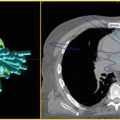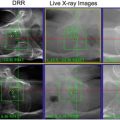© Springer International Publishing Switzerland 2016
Rajni A. Sethi, Igor J. Barani, David A. Larson and Mack Roach, III (eds.)Handbook of Evidence-Based Stereotactic Radiosurgery and Stereotactic Body Radiotherapy10.1007/978-3-319-21897-7_66. Head and Neck
(1)
Department of Radiation Oncology, University of California, San Francisco, 1600 Divisadero Street, Suite H-1031, San Francisco, CA 94143, USA
Pearls
~52,140 cases/year and 11,460 deaths in the USA from head and neck cancer (M:W, ~3:1), comprising 6.5 % of new cancer diagnoses in the USA (Jemal et al. 2010).
5-year survival rates range between 50 and 75 % but for local-regionally advanced disease (60 % of new diagnoses), they are as low as 30 % (Ries et al. 1988; Vokes et al. 1993).
5-year survival for early local recurrence ~25–35 % and for more advanced recurrence, ~15–20 % (Lee & Esclamado 2005).
At present SBRT has no clearly established or widely accepted role in the definitive management of newly diagnosed, non-metastatic disease or for curative intent multimodality reirradiation.
The potentially serious risks of SBRT should be cautiously weighed against the competing risks of symptomatic tumor progression and the feasibility and efficacy of alternative treatment options.
Work-Up
H&P, including performance status , HPV status, smoking and alcohol history, prior history of treatment to the head and neck.
Review of symptoms, including
Bleeding.
Pain.
Weight loss/nutritional status.
Pre-existing dysphagia .
Neuropathies.
Laboratories
CBC , BUN, Cr, LFTs, alkaline phosphatase , and LDH .
Imaging
MRI of the primary site and neck ± upper mediastinum .
CT chest with contrast ± CT abdomen and pelvis or PETCT as indicated.
Pathology
FNA or ultrasound/CT-guided biopsy for accessible lesions.
Treatment Indications
Early-stage head and neck cancers are definitively managed by local therapy, with single-modality surgical resection or external beam radiation therapy (EBRT ) as usual standard of care. EBRT is more frequently employed for medically inoperable, high-risk, or elderly patients.
Multimodal therapy, nearly always including EBRT combined with surgery , chemotherapy, or both, is frequently employed for locally or regionally advanced head and neck cancer.
SBRT is now selectively employed at a limited number of centers for small-volume recurrence or palliation.
SBRT has been reported as a fractionated stereotactic boost following definitive (chemo)radiation for locally advanced nasopharyngeal cancers.
A few reports exist combining SBRT with concurrent targeted therapy or cytotoxic chemotherapy but these combinations remain investigational.
Radiosurgical Technique
Simulation and Treatment Planning
Thin-cut CT (1–1.5 mm) thickness recommended.
GTV contoured from fusion of MRI with/without gadolinium contrast , merged in the area of interest to the planning CT.
CTV margins may range from 0 to 10 mm depending on clinical scenario:
For recurrent disease, margins up to 5–10 mm may be considered depending on the degree of tumor infiltration into surrounding tissues.
For well-delineated disease at the skull base, where high-stability or real-time localization of the setup is expected, 0–3 mm margins could be considered.
For palliation, no margin may be prudent to minimize toxicity.
PTV = CTV + 1–5 mm (dependent upon available center-specific image guidance and site-specific motion considerations).
State of the art tracking localization or frequent IGRT are recommended to reduce setup uncertainty and margins.
Goal should be for low-dose to proximal OARs, achieved by use of an increased number of beams and angles, as well as minimization of margins.
Phantom-based QA on all treatment plans prior to delivery.
Dose Prescription
Dose and fractionation outside of the range of conventional fractionation for head and neck cancer (1.8–2.0 Gy/fraction/day) are not clearly defined in terms of alterations in safety profile or gains in efficacy.
Planning should be determined with a high level of attention to potential adjacent normal tissue toxicity.
For SBRT -based single-modality reirradiation and SBRT boost following EBRT , prescriptions vary widely depending on the clinical scenario; practitioners are advised to consult the primary literature to identify applicable solutions. For reirradiation, the most commonly reported dose range is 30–50 Gy over 5 fractions.
Ideally prescribe to ≥80 % isodose line (IDL ), ≥95 % PTV coverage with prescription dose; depending on characteristics of treatment planning system, 50–60 % IDL is acceptable only if high-dose heterogeneity and fall off are thoroughly reviewed for safety.
Composite planning should be employed in cases of reirradiation , with appropriate BED conversion for dose summation.
Dose Limitations
Dose and fractionation schemas largely empirically determined.
Almost no reports address normal organ tolerances for hypofractionated regimens in any detail.
A dose-escalation study of SBRT -based reirradiation at the University of Pittsburgh used the following general constraints for a 5-fraction regimen: spinal cord ≤ 8 Gy, brain stem ≤ 8 Gy, larynx ≤ 20 Gy, and mandible ≤ 20 Gy. Doses given to the oral cavity and parotid glands were based on patient-specific factors.
A prospective phase II French study restricted the repeat dose to a fully previously radiated spinal cord to ≤ 6 Gy point dose over 6 fractions.
In general, the dose per fraction should be less than 2.5 Gy per fraction to as much tissue as possible, with special attention to pharyngeal, vascular, or other reirradiated structures prone to late complications. Tissue receiving above 4 Gy per fraction should be strictly minimized.
Stay updated, free articles. Join our Telegram channel

Full access? Get Clinical Tree





